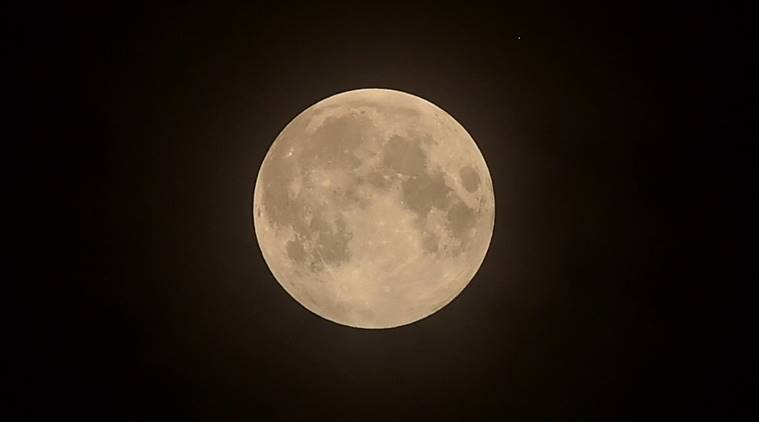 While the Moon will briefly be at its fullest on Monday, it will appear full for three days — from Saturday night until Tuesday morning. (PTI file photo)
While the Moon will briefly be at its fullest on Monday, it will appear full for three days — from Saturday night until Tuesday morning. (PTI file photo)
Stargazers across the world will get to witness November’s full moon, also known as the ‘Beaver Moon’, reaching its peak illumination on Monday, before passing through the Earth’s outer shadow in a penumbral lunar eclipse — the last one of the year.
The ‘Beaver Moon’ has lit up the night sky since Saturday, and will continue to be seen until Tuesday morning. But on Monday, it will be briefly visible at its fullest.
Spectators in North and South America, Europe, Australia and a few parts of Asia will be able to catch a glimpse of the astronomical event. However, the lunar eclipse will not be visible in India as the Moon will be below the horizon.
Why is the November full moon known ass the ‘Beaver Moon’?
The full moon in November is often referred to as the ‘Beaver Moon’ in parts of North America as it graces the sky in the month when beavers begin taking shelter in their lodges after storing enough food for the winter. It is also the time of fur trade in the region, when hunters lay out traps to catch beavers for their pelts.
But the full moon in November, the final one before the winter solistice, has many names around the world. It is also known as the Cold Moon, Frost Moon, Winter Moon, Oak Moon, Moon Before Yule, Child Moon, Kartik Purnima, Karthika Deepam and Tazaungdaing Festival Moon, and Ill Poya.
What is a penumbral lunar eclipse?
Penumbral lunar eclipses are distinct from total or partial eclipses. While in a total lunar eclipse, the Earth comes in between the Sun and the Moon, stopping the light of the sun from reaching the Moon and casting a shadow on it; during a partial eclipse, the Moon passes through the Earth’s inner shadow or ‘umbra’.
Meanwhile, in a penumbral lunar eclipse the Moon moves through the outer part of the Earth’s shadow, known as the ‘penumbra’, as a result of which it becomes very faint. As it glides through our planet’s penumbra, around 83 per cent of the moon will appear to lose its brightness for a few hours.
What are the phases of the ‘Beaver Moon’ lunar eclipse?
Around 20 minutes before the deepest phase of the ‘Beaver Moon’ eclipse, faint penumbral shading will be visible along the upper edge of the moon. After this comes the most intense part of the eclipse, when a part of the moon appears to be shrouded in charcoal grey hue. Once the deepest phase has passed, a slight smudging of grey may be visible on the right edge of the moon for around 20 more minutes.
When will the astronomical events take place?
According to timeanddate.com, the lunar eclipse will start at 1:04 PM IST and end at around 5:22 PM IST. But unfortunately sky watchers in India will not be able to see the eclipse as the Moon will be below the horizon here. A number of live streams will be available online for interested viewers.
Lima, Peru will be the first to see the penumbral eclipse at 2:32 AM (local time). While the penumbral eclipse will be detectable in parts of South America as the moon starts to set, people in Central Asia and Australia will be able to see it while the moon is rising.
But experts say that the event will be difficult to catch without proper instrumentation. “The dimming of the Moon during this eclipse will probably not be noticeable without instrumentation, but for spacecraft at the Moon such as the Lunar Reconnaissance Orbiter (LRO) the reduction in solar power will be noticeable,” NASA wrote in a statement.
When will the next lunar eclipse take place?
The next lunar eclipse is slated to take place on May 26, 2021. It will be a total lunar eclipse.